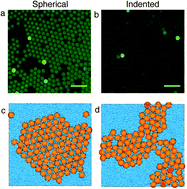Self-assembly and crystallisation of indented colloids at a planar wall
Abstract
We report experimental and simulation studies of the structure of a monolayer of indented (“lock and key”) colloids, on a planar surface. On adding a non-absorbing polymer with prescribed radius and volume fraction, depletion interactions are induced between the colloids, with controlled range and strength. For spherical particles, this leads to crystallisation, but the indented colloids crystallise less easily than spheres, in both simulation and experiment. Nevertheless, simulations show that indented colloids do form plastic (rotator) crystals. We discuss the conditions under which this occurs, and the possibilities of lower-symmetry crystal states. We also comment on the kinetic accessibility of these states.



 Please wait while we load your content...
Please wait while we load your content...